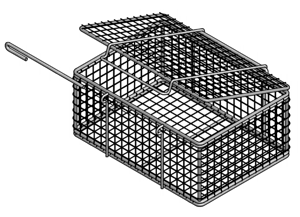 For sanitary food handling applications, stainless steel is a popular material choice. Not only can food-grade stainless steel stand up to punishing temperatures that would melt plastic, the material’s protective oxide layer helps prevent the formation of rust that could contaminate foodstuffs.
For sanitary food handling applications, stainless steel is a popular material choice. Not only can food-grade stainless steel stand up to punishing temperatures that would melt plastic, the material’s protective oxide layer helps prevent the formation of rust that could contaminate foodstuffs.
But, as with any material, there are a few things that you should know about food-grade stainless steel before you implement it in your production process.
1: The Steel’s Finish Can Affect its Suitability for Food Processing
Stainless steel is famous for being able to resist corrosion, but just because the surface of the steel looks shiny and smooth doesn’t mean that it’s food-grade.
To meet key sanitary standards, the finish of the steel MUST eliminate any surfaces that could result in bacterial growth while being easy to clean/sanitize.
Here, processes such as electropolishing are favored over manually grinding down surfaces. The reason for this is that electropolishing strips away the surface layer of steel to reveal a microscopically-smooth substrate.
This not only enhances the strength of the oxide layer in stainless steel; it removes the microscopic flaws in a surface that could harbor bacteria.
Learn how passivation and electropolishing can protect your custom food-grade metal forms!
2: Stainless Steel Should NEVER Be Cleaned with a Plain Steel Brush
 Steel wire brushes are a popular choice for cleaning deep-set stains from metal surfaces. However, such brushes should NEVER be used to clean a stainless steel object.
Steel wire brushes are a popular choice for cleaning deep-set stains from metal surfaces. However, such brushes should NEVER be used to clean a stainless steel object.
Particles from the plain steel in the brush could become imbedded in the surface of the stainless steel, compromising the integrity of the protective oxide layer. Over time, this will allow the “stainless” steel to rust like ordinary steel.
Additionally, you should avoid using the same tools to clean both stainless and ordinary steels. Particles picked up from the plain steel could transfer to the stainless.
3: Not All Food-Grade Stainless Steel Alloys Are Created Equal
Just because a steel alloy is marketed as being “food grade” doesn’t mean it’s the right material for your production process.
There are a number of different stainless steel alloys on the market, each with its own strengths and weaknesses when it comes to resisting specific chemicals and production environments.
For example, salt is known for being exceptionally corrosive to metal compounds. While grade 304 stainless steel is resistant to most corrosives, prolonged exposure to salt can still eat away at it. So, grade 304 stainless wouldn’t be suitable for any process requiring repeated, prolonged exposure to salt or saltwater.
Grade 316 stainless, on the other hand, is much more resistant to salt exposure than grade 304. This makes grade 316 stainless steel preferable for food makers that use salt or saltwater in their products.
4: Temperature Extremes CAN Affect Food-Grade Stainless Steel
 Most stainless steels have a melting point well outside of the temperature ranges typically employed in any food manufacturing process. However, it is still important to be careful of temperature extremes in your manufacturing process when selecting a food-grade stainless steel (and any potential coatings for it).
Most stainless steels have a melting point well outside of the temperature ranges typically employed in any food manufacturing process. However, it is still important to be careful of temperature extremes in your manufacturing process when selecting a food-grade stainless steel (and any potential coatings for it).
For example, most formulations of stainless steel are fine at temperatures ranging from the freezing point of water to oven-like temperatures in excess of 500ºF. However, according to Gasparini Industries, truly cryogenic conditions below -49ºF can cause many stainless steel alloys to become brittle. This, combined with crystalline expansion as metals heat up, can cause these metals to warp or break if exposed to sudden extreme temperature shifts.
Among stainless steels, martensitic stainless steels tend to handle extremely low temperatures the best. This is because the structure of martensitic stainless steel is less susceptible to becoming brittle when exposed to low temperatures.
Additionally, it's important to consider the risk of oxidation when using a food-grade stainless steel alloy in high temperatures. For such applications, grade 304 stainless steel is often useful because of its ability to resist oxidation at temperatures of up to 1,697ºF. This is well over the limit of virtually any food manufacturing process (outside of sterilizing baskets between uses).
5: Welding Can Alter the Properties of Stainless Steel Alloys
The heat stress applied during some welding processes (as well as the use of dissimilar filler materials) can strip the protective oxide layer that gives food-grade stainless steel alloys their resistance to corrosion. This, in turn, can make metal forms that have been welded improperly start to corrode faster than they should.
This is why Marlin's degreed engineers use a resistance welding method applied via a high-precision medium frequency direct current (MFDC) machine. Because the machine can accurately complete welds without excess heat or filler material, the risk of altering the protective oxide layer of the steel being welded is minimized.
Getting to know the strengths and weaknesses of stainless steel prior to implementing it in your food production process is critical for ensuring safety, sanitation, and efficiency. Learn more about stainless steel from the experts at Marlin Steel today!
Related Blogs:








.gif)


